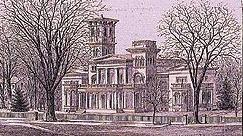Ithiel Town
Ithiel Town | |
|---|---|
| Born | October 3, 1784 |
| Died | June 13, 1844 |
| Nationality | American |
| Occupation | Architect |
| Buildings | Center Church Trinity Church Wadsworth Atheneum |

Ithiel Town (October 3, 1784 - June 13, 1844) was a prominent American architect and civil engineer.
Town was born in Thompson, Connecticut to Archelaus and Martha (Johnson) Town. He trained with the eminent Asher Benjamin in Boston and began his own professional career with the Asa Gray House (1810).
His earliest important architectural works include Center Church (1812-1815), and Trinity Church (1813-1816, one of the earliest Gothic Revival churches in America) on the New Haven Green in New Haven, Connecticut. In 1820, he designed and patented a form of the wooden truss bridge, Town's Lattice Truss, which became widely used throughout the United States. Town's truss design can still be seen in two of Connecticut's remaining covered bridges, Bull's Bridge in Kent and West Cornwall Bridge in Cornwall and Sharon. Many other extant covered bridges also employ Town's basic design.

In 1829, Town formed one of the first professional architectural firms in the United States with Alexander Jackson Davis, together producing notable buildings in a range of new Revival styles, including Greek, Gothic, Tuscan, and Egyptian. The firm lasted until 1835; for eighteen months in 1832-1833, it operated as Town, Davis, and Dakin, when James H. Dakin joined the firm. Their works included the state capitol in New Haven, the city hall and Wadsworth Atheneum in Hartford, Connecticut, the capitol buildings of Indiana, and North Carolina (1833-1840), and the U.S. Custom House, now Federal Hall, in New York City (1833-1842). During this time, Town also designed the Potomac Aqueduct in Washington, D.C. (1833-1843), which allowed fully loaded canal boats to cross the Potomac River. It was considered one of the most remarkable engineering feats of the time.
Town designed his New Haven home on Hillhouse Avenue in the Greek Revival style; here he kept what was then an extraordinary architectural library — an inspiration to many, including Davis and another noted New Haven architect, Henry Austin. The house was later owned by Joseph Earl Sheffield, benefactor of the Sheffield Scientific School and modified by Austin. Town designed a number of stately homes on Hillhouse. In 1825, Town was awarded an MA degree from Yale University and subsequently left many of his books to Yale upon his death.
In 1825, Town also became one of the original members of the National Academy of Design, and traveled in Europe in 1829-30. In 1839, Town commissioned noted American painter Thomas Cole to execute a painting called The Architect's Dream, which now hangs in the Toledo Museum of Art. Town died in New Haven on June 13, 1844, and is interred in Grove Street Cemetery, New Haven, Connecticut.
Selected Works
- Asa Gray House, Cambridge, Massachusetts, 1810. Federal
- Center Church, New Haven, Connecticut, 1812-1815. Federal
- Trinity Church, New Haven, Connecticut, 1813-1816, Gothic Revival
- Samuel Wadsworth Russell House, Wesleyan University, Middletown, Connecticut, 1828. Greek revival
- Wadsworth Atheneum, Hartford, Connecticut, 1842. Gothic revival
- Leake and Watt's Children's Home, New York, New York, 1843. Gothic revival
- State capitol, New Haven, Connecticut, 1837. Greek revival. Razed
- Ithiel Town (Sheffield) Mansion, New Haven, Connecticut. Greek revival. Razed
Selected writings
- Description of his Improvements in the Construction of Bridges (Salem, 1821)
- A Detail of Some Particular Services Performed in America, During the Years 1776, 1777, 1778, and 1779, Compiled from Journals and Original Papers...taken from the Journal Kept on Board of the Ship 'Rainbow' Commanded By Sir George Collier (New York, 1835)
- Atlantic Steamships. Ideas and Statements, The Result of Considerable Reflection on the Subject of Navigating the Atlantic Ocean with Steam-Ships of Large Tonnage. Also, the Arrival, Description, and Departure of the Two First British Steam-Ships (Wiley & Putnam/J. P. Wright, New York, 1838)
